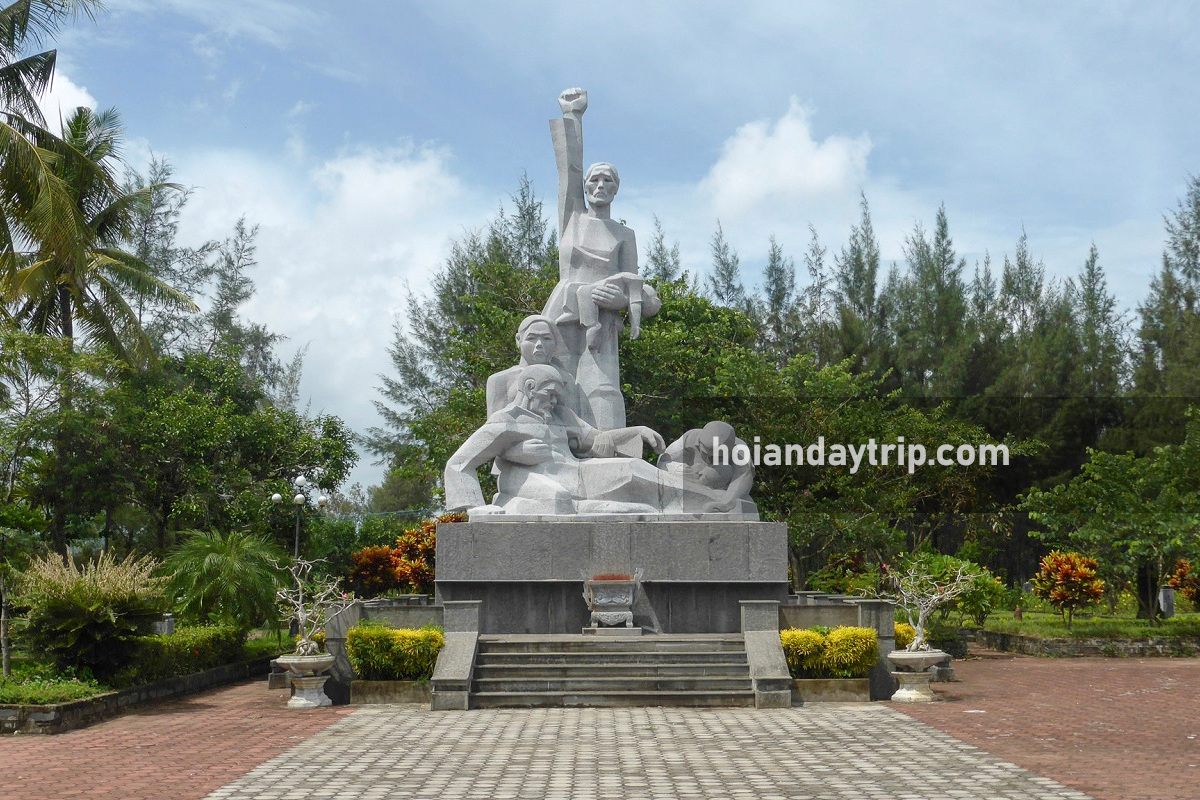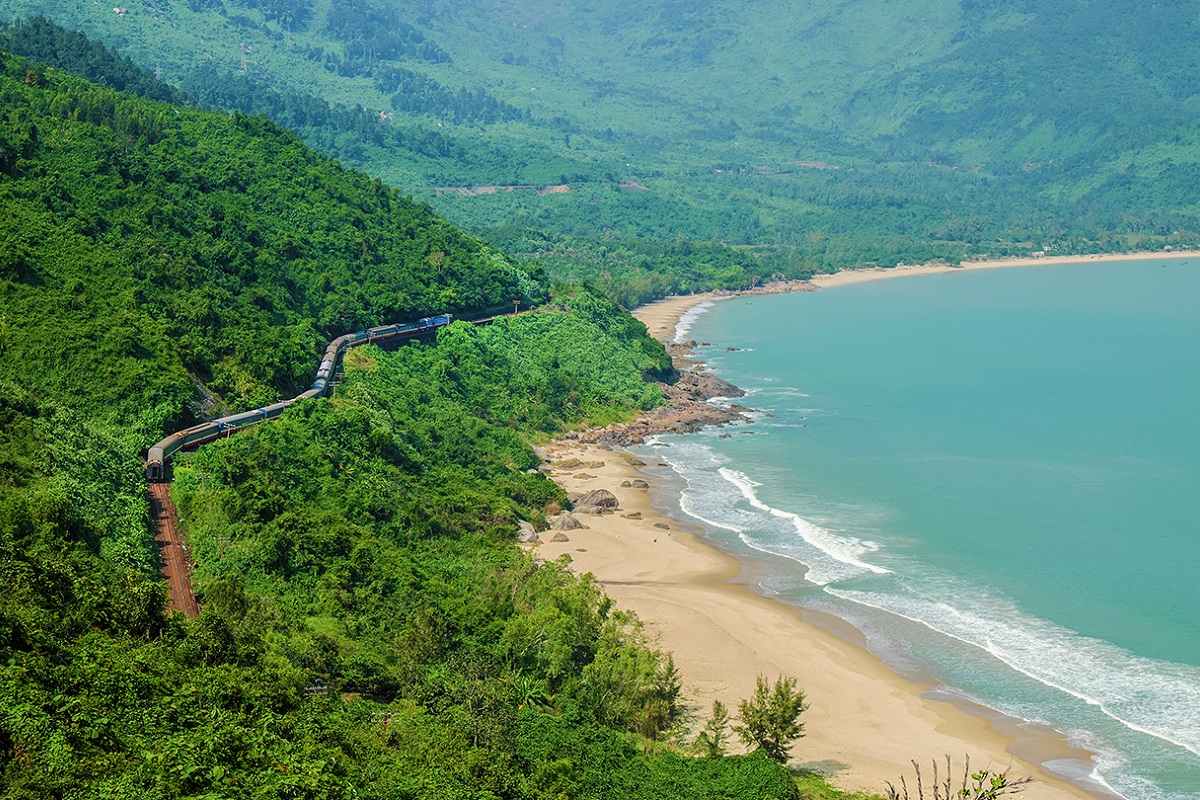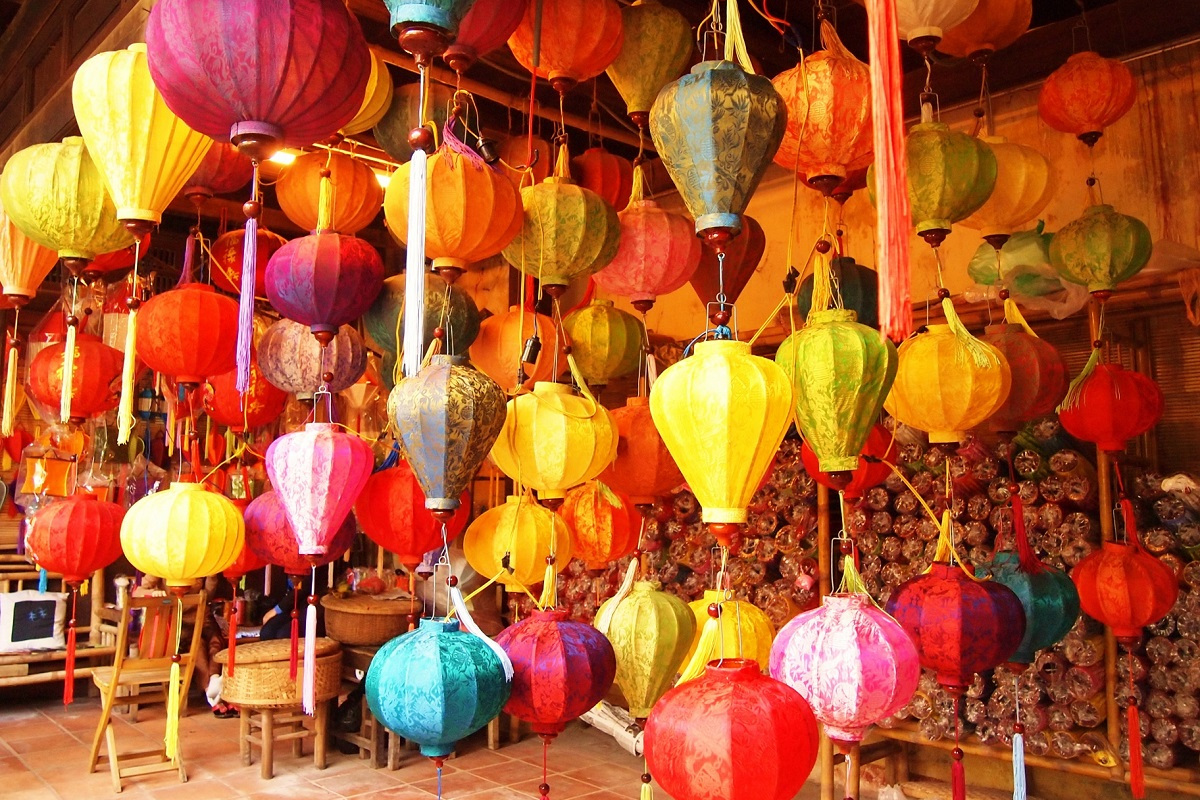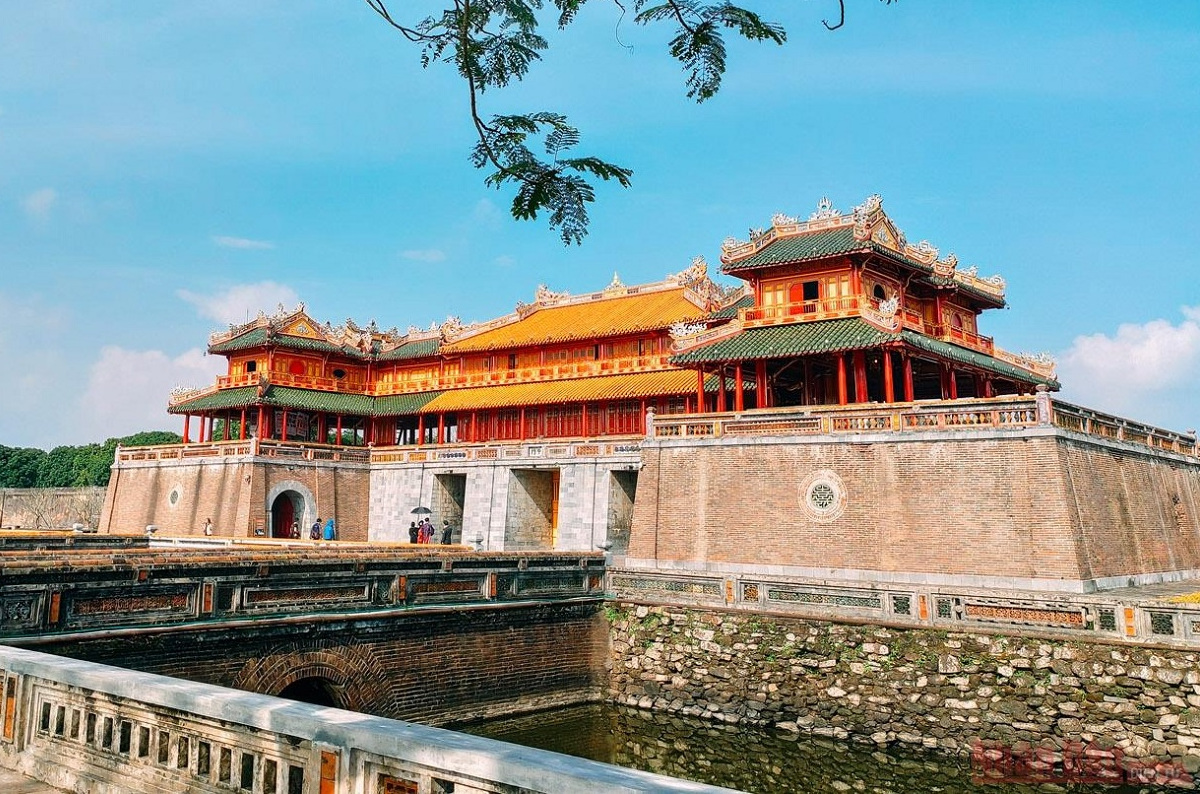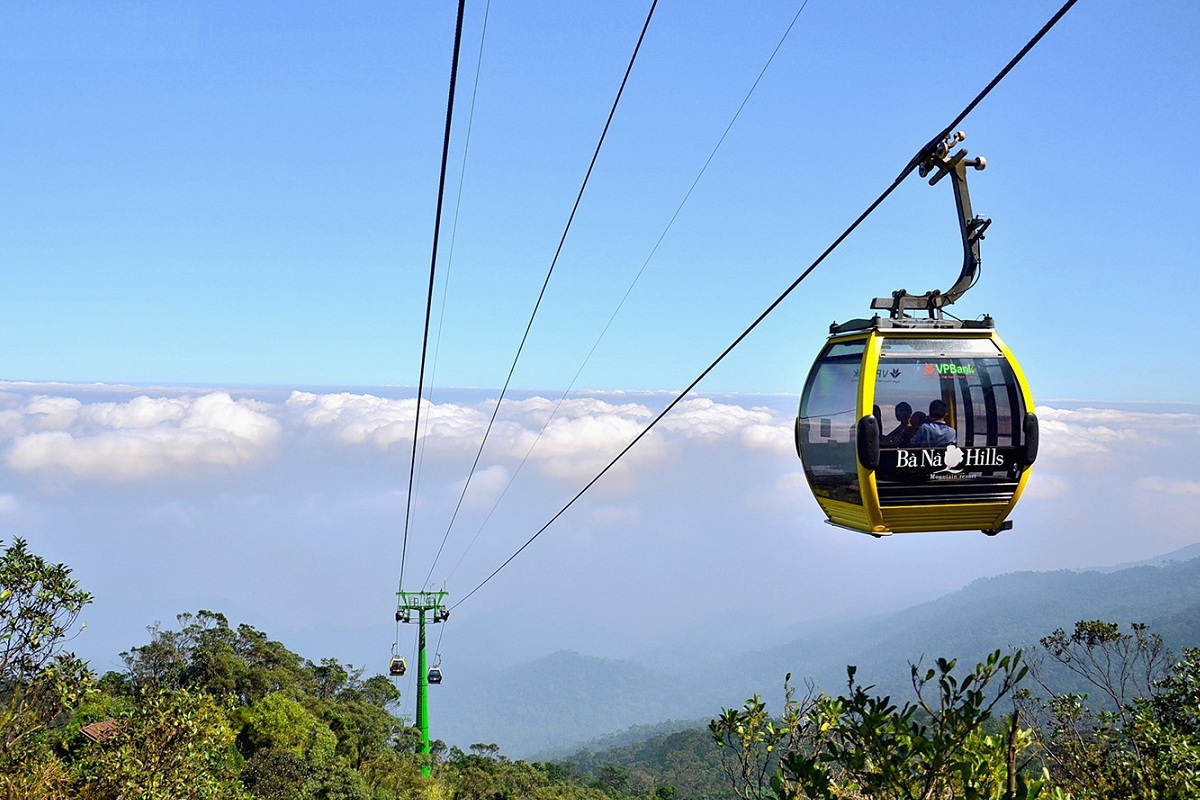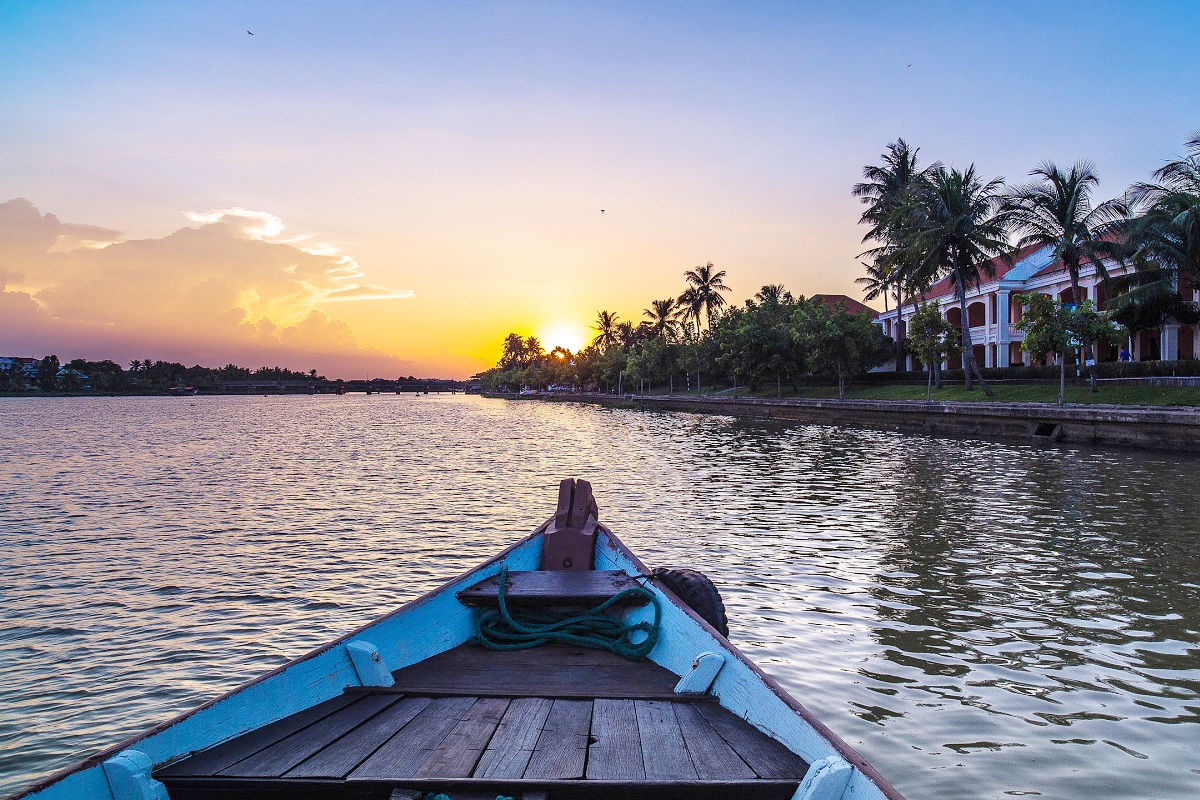Tomb of Khai Dinh is the last emperor mausoleum built in Hue and Vietnam. It’s famous for one-of-the-kind architecture and art that was never seen in the country at that time. There, concrete cement, ceramic, glass and metal replaced timbers, and gardens, trees and lakes disappeared. Local people say that these express the different personality of the owner, the Khai Dinh king who was close to French. Ever thought to be a waste of money and weird-style building, today the tomb attracts lots of visitors coming to admire a special heritage. No doubt that its images are more popular than other royal tombs in social media. In 1993, it’s within the Complex of Hue Monuments which was inscribed by Unesco as a world heritage site.
This travel guide focuses on the Tomb of Khai Dinh, from its location, history, architecture, to life of its owner. Other traveler’s cares such as ticket, fees, transport, tours, tips, and more are provided as well. We recommend reading other articles about Tomb of Tu Duc, Tomb of Minh Mang and general one for Hue’s Imperial Tombs (a comparison included). Hopefully after checking out, you can find the next stunner to explore.
Read also:

Table of content
- 1 Basics that Every Traveler Should Know
- 2 About Khai Dinh Emperor
- 3 Tomb of Khai Dinh Location – Feng Shui Principles
- 4 History of Khai Dinh Tomb
- 5 Khai Dinh Tomb Architecture and Explainations
- 6 Tomb of Khai Dinh’s Distinction
- 7 How to Get to Khai Dinh Tomb
- 8 Things to Do near Tomb of Khai Dinh
- 9 Tomb of Khai Dinh Tour
- 10 Tomb of Khai Dinh on Google Maps
- 11 Related Posts
- 12 Thieu Tri Tomb: The Peaceful Royal Tomb of Hue
- 13 Bach Ma National Park: Hiking, Trekking in Da Nang and Hoi An
- 14 Hue to Da Nang By Train: The Best Train Ride in Vietnam
- 15 Hue Royal Tombs: A Complete Guide and What is Best?
- 16 The Hue Abandoned Water Park (Thuy Tien Lake Waterpark)
- 17 Minh Mang Tomb Complete Visitor Guide
- 18 Tu Duc Tomb Complete Visitor Guide
- 19 Hoi An or Hue: Which is Better?
- 20 Lang Co Vietnam Travel Guide
- 21 Thien Mu Pagoda: Guide to Hue’s Most Famous Buddhist Temple
- 22 Perfume River Cruise: Guide to Best Boat Tour in Hue Vietnam
- 23 Tomb of Khai Dinh: The Most Unique Royal Tomb of Hue
- 24 Hai Van Pass Da Nang: Map, Route, Weather, History, Tour
- 25 Hue Imperial City and Forbidden City
- 26 Featured Tours and Experiences
- 26.0.1 Bach Ma National Park Tour from Hue
- 26.0.2 Bach Ma National Park Tour from Da Nang/Hoi An
- 26.0.3 Hoi An Sunrise Fish Market Tour
- 26.0.4 My Lai Massacre Tour
- 26.0.5 Golden Bridge/Ba Na Hills & Hoi An Tour
- 26.0.6 Hoi An Instagram Tour
- 26.0.7 Ky Anh Tunnel & Tam Thanh Mural Village Tour
- 26.0.8 Da Nang to Hue Motorbike Tour with Hai Van Pass & Easy Rider (1 Way)
- 26.0.9 Hue to Da Nang Motorbike Tour with Hai Van Pass & Easy Ride (1 Way)
- 26.0.10 Hue to Hoi An Motorbike Tour with Hai Van Pass & Easy Rider (1 Way)
- 26.0.11 Hoi An to Hue Motorbike Tour with Hai Van Pass & Easy Rider (1 Way)
- 26.0.12 Tra Que Vegetable Village Tour with Cooking Class
- 26.0.13 Ba Na Hills Half Day Tour from Hoi An
- 26.0.14 Marble Mountain & Hoi An Day Tour from Da Nang Port
- 26.0.15 Hue Day Tour from Chan May Port with Lunch
- 26.0.16 Marble Mountain & Hoi An Tour from Chan May Port
- 26.0.17 Ba Na Hills/Golden Bridge Tour from Da Nang Port
- 26.0.18 Ba Na Hills/Golden Bridge Tour from Chan May Port
- 26.0.19 Golden Bridge Private Tour with Ba Na Hills & Lunch
- 26.0.20 Ba Na Hills Afternoon Tour with Golden Hands Bridge
- 26.0.21 Ba Na Hills Private Tour with Golden Hands Bridge
- 26.0.22 Ba Na Hills Half Day Tour with Golden Bridge
- 26.0.23 Ba Na Hills Early Morning Tour to Beat the Crowds
- 26.0.24 Golden Bridge and Ba Na Hills Night Tour
- 26.0.25 Golden Hands Bridge Tour In Sunrise or Sunset (1/2 Day)
- 26.0.26 Cam Kim Island Bicycle Tour From Hoi An
- 26.0.27 Cham Island Tour From Hoi An (Group Tour)
- 26.0.28 Cham Island Tour From Da Nang (Group Tour)
- 26.0.29 Hoi An Vegetarian Food Tour
- 26.0.30 Hoi An Evening Walking Food Tour with Local Foodie
- 26.0.31 Private Hoi An Basket Boat Tour (Shuttle Bus, Bicycle, Bike)
- 26.0.32 Half-day Am Phu Cave Tour (Private)
- 26.0.33 Hoi An Countryside Tour by Electric Car or Bike
- 26.0.34 Da Nang Tour Package From Singapore
- 26.0.35 Hoi An Evening Tour From Da Nang with Lantern Boat Ride
- 26.0.36 Hoi An Walking Food Tour Through Laneways
- 26.0.37 My Son Sanctuary and Hoi An Old Town Tour
- 26.0.38 My Son Day Trip From Hoi An including Marble Mountains and Basket Boat
- 26.0.39 Half Day Hoi An City Tour With River Cruise
- 26.0.40 Son Tra Peninsula Tour with Marble Mountains (Private/Small Group)
- 26.0.41 Hue Day Trip From Hoi An with Hai Van Pass, River Cruise & Lunch
- 26.0.42 Hoi An Ancient Town and Countryside Tour (Bests of Hoi An Tour)
- 26.0.43 Hoi An Tour From Da Nang Airport (Private, Optional Lunch)
- 26.0.44 Hoi An Day Trip From Da Nang (Marble Mountains, Basket Boat, Old Town)
- 26.0.45 Da Nang City Tour From Airport (Private, Optional Lunch)
- 26.0.46 Hoi An City Tour with Lantern Class, Lantern Boat, Night Market & Local Food Sampling
- 26.0.47 Marble Mountains, Basket Boat Ride & Hoi An Old Town Walking Tour
- 26.0.48 Marble Mountains & Golden Bridge/Ba Na Hills Day Tour
- 26.0.49 Marble Mountains & Monkey Mountain Tour (Half-day, Private)
- 26.0.50 Private Golden Bridge Sunrise Tour (Half-day, Optional Lunch)
Basics that Every Traveler Should Know
What is the Tomb of Khai Dinh?
Tomb of Khai Dinh (or Mausoleum of Emperor Khai Dinh, Khai Dinh Royal Tomb, Royal Tomb of Khai Dinh King, Khai Dinh Tomb) is the burial place of 12nd emperor of the Nguyen Dynasty. It’s the longest built, most expensive, most sophisticated and strangest of all 7 royal tombs in Hue. Located on a hill beside a wide road 10 km south of city center, this fantastic attraction is accessible by every vehicle. Because of steep staircases, visitors should ask old and little members of the family, go or not, before buying any ticket. Same to other mausoleums, there are lots of photo opportunities here.
Fact: The tomb was designed totally by its owner, Khai Dinh king who was seen as the bridge between East and West cultures in his lifetime. Up to date, many things from this unique building have been copied and inspired architects and artists.
Khai Dinh Tomb Opening Hours
Khai Dinh Tomb opening hours are from 6:30 a.m to 5:30 p.m in the dry season (March to August) and from 7 a.m to 5 p.m in the wet season (September to February).
Khai Dinh Tomb Entrance Fee and Ticket
Khai Dinh Tomb entrance fee is 150,000 VND for adults and visitors above 12 years-old or with a height over 1,3 meters. It’s 30,000 VND for ages from 7 to 12 or heights from 0,8 to 1,3 meters, and free for smaller ones. Not necessary to preserve in advance because can’t. Even during the peak seasons, tickets are still a lot.
On the other hand, three ticket combos are also available for visitors who plan to see more than just a tomb. The first combo includes the Imperial city and Minh Mang Tomb. It costs 420,000 VND for adults and 80,000 VND for childrens. The second combo is with Tu Duc Tomb addition. Its price is 530,000 VND and 100,000 VND respectively. The last selection allows sightseeing in all places in the Complex of Hue Monuments. An adult will pay 580,000 VND and 110,000 VND for their little ones. The validity is within 3 days from the day when visitors buy the ticket. Because of being physical, ticket holders should keep careful.
*The all-site ticket covers the admission to these places: the Imperial City & Forbidden Purple City, Museum of Royal Antiquities, Tombs of Gia Long, Minh Mang, Tu Duc, Duc Duc and Khai Dinh kings, An Dinh palace, Nam Giao altar, and some others.
Travel Tips
Khai Dinh Tomb has 127 steps and much of which are steep. If traveling with kids or elders, asking them that can they climb up or not before purchasing the tickets. While it’s raining, the staircases are slippery, waterfall-like. So, shouldn’t visit this attraction at the time. After the rains, the temperature is cooler and it’s perfect to walk up and sightsee. In the dry season, visitors should come in the early morning or late afternoon, to avoid the midday heat. Because of without shaded trees,
Dress code is required if visitors would like to walk in the worshipping palace. Just ensure that the clothings cover enough to express the respect to the king. Armpits, navel and knees are needed to cover. See-through fabric garments are not thought to be okay by locals. Keep in mind to remove the sunglasses, hat/cap, umbrella or raincoat. Don’t need to take off shoes. According to official regulations, sightseers are not allowed to take photos with flash light (to preserve better heritages).

About Khai Dinh Emperor
Family and Road to Coronation
Khai Dinh (birth name Nguyen Phuc Buu Dao) is 12nd king of the Nguyen Dynasty. He was borned in 8/10/1885 in the Hue Royal Palace and passed away on 6/11/1925, after his 40 years birthday. This short man was the oldest son of the 10th king Dong Khanh and the first wife Duong Thi Thuc. He had 7 siblings, however three of them couldn’t live to adulthood, and so, he became the only boy still alive.
After his father died young, mandarins and French didn’t not choose him to be the successor because he was small at that time (4 years old). Instead, 10-years-old Thanh Thai prince and later, 7-years-old Duy Tan prince were selected in turn. But both were quickly expelled due to their struggles against the French. After “delays”, Khai Dinh’s coronation ceremony finally was held in 1916, at the age of 31.
Throughout his life, he got married with 12 ladies but only one had children with him. That’s the mother of Bao Dai king later. Because of being not really close much to women, Khai Dinh was a gay in the eyes of people. No surprise, his mother investigated very carefully when his wife was pregnant. But nothing was revealed although someone knew that she had sex with an imperial guard previously.
Reign of Khai Dinh King
During 9-years reign from 1916 to 1925, Khai Dinh king had a very close relationship with the French, more than any predecessors. Instead of spending time being in charge of national issues, he liked gambling. Lots of precious objects and money were used to have fun in games, from day to day. Even his wife had to return to her parents’ home to take money for him. After raising the tax 30% to build his tomb, people in the country got angry. Their life became more difficult and no surprise, they said that he was the worst emperor.
In 1922, this puppet emperor was invited to visit the Marseille colonial exhibition in France, under the name “King of the French Protectorate of Annam”. He became the first Vietnamese ruler traveling abroad in history. There, he wore an imperial costume designed by himself, with icons, lights, conical hat and more. People in France whispered that his style was very weird (in point of view at that time). By chance, Ho Chi Minh (president) lived and worked in the country meanwhile. He made a play named “the Bamboo Dragon ” and a mocking piece of writing to ridicule him.
Bao Dai – Khai Dinh King’s Successor
Bao Dai (or Nguyen Phuc Vinh Thuy) was the only son (children) of Khai Dinh king. He was borned in 1913, and ruled Vietnam from 1925 to 1945. Life of Vietnam’s last emperor is related to number 13, which is not lucky in many cultures. First coincidence is his year of birth, 1913. In the Nguyen dynasty, he was the 13th king and crowned at the age of 13. This man has 13 childrens with the Empress Nam Phuong. After passed away, he was buried at 13h, one hour later than the original plan because of heavy rains.
In 1945, Bao Dai was abdicated in Ngo Mon, the main gate of the Imperial City and became a Vietnam citizen after that.
Tomb of Khai Dinh Location – Feng Shui Principles
In the upstream of the Perfume River, the location of the Tomb of Khai Dinh met all feng shui requirements. Firstly, it sits on a gentle hill that plays the role as a backrest for the king to relax, and faces the west, a representation of the king’s death. From it, visitors can see a flat-bottomed valley that is not too wide or narrow. Geomancies say it’s perfect for “a front view”. On either side, Kim Son and Chop Vung mountains were “blue dragon” and “white tiger”, sheltering the building from evils and bad spirits. Around the foothill, a small river runs from the left to right, symbolizing peacefulness, prosperity and abundance.
Fact: Founder of the Nguyen dynasty didn’t know which place better to choose (for burying him) between this and another. Finally, he refused it because he found five-colored soil in where his tomb stands today.

History of Khai Dinh Tomb
Khai Dinh Tomb was built from 4/9/1920 to 1931, in the reign of two emperors: its owner and his son Bao Dai. This construction time is the longest in Vietnam history for an imperial mausoleum. There were some thousands of workers mobilized, including plenty of skillful artisans from Hue and the outside. Because of the remote mountainous location, they faced the death caused by malaria, and poor treatments. Nowadays, local people still pass on the verse, “Chau E…When come to (the tomb), still see but when return to, can’t see (because died)”. The survivors used what they knew in ceramic mosaics to earn for living later.
Due to shortage of money, Khai Dinh allowed increasing farming tax up to 30%, to finance the construction. This decision made his subjects so angry and even thought that he was the worst ruler ever. In 1925, he passed away while the tomb was not completed yet. In the burial ceremony, the French visited and took many photos about it (and procession to bring the king’s coffin from the palaces). The Governor-General of Indochina, and the Administrator of the French Protectorate of Annam also attended, because of the close relationship. A huge josh paper, similar to Kien Trung Palace where Khai Dinh’s family lived, was brought here to burn for him for the next life. As a very important event, lots of commoners came to see.


Khai Dinh Tomb Architecture and Explainations
First Terrace
The staircase from the road to the main door, features steep steps and 4 dragons crawling down. Nowhere else around Hue, visitors can see the holy animal with larger sizes. The eyes of dragons are created by French wine bottles. While visiting, keep in mind that nearly all of the things in the tomb have at least a difference to their kind. Ticket check point is in the right walkway, and the left walkway is for exit. To either side of the first paved yard, there are two mandarin halls (houses) where the officials formerlyprepared everything and rested before ceremonies occurred . To get to higher terraces, visitors again need to walk upstairs on many and high steps. During the rains, water flows down from the top to here, creating graded falls. In the spring, flowers are added there, to allow visitors to take pictures.
Second Terrace – Mandarin Courtyard & Stele Pavilion
The second terrace of Khai Dinh Tomb is called “Mandarin courtyard”. It owns 4 rows of stone statues, more than anywhere in Hue, and two for each side. 7 solemn military and literature mandarins stand in the front, and an elephant, a horse and 5 guards are placed behind. Thanks to uniqueness, epic and majesty, these sculptures are loved by instagrammers who photograph for social media posts. To explain why 4 rows instead of 2 traditionally, historians say that it is a way to show the personality of the king who liked differences.
Constructed near the statues, the Stele pavilion is home of a memorial stele named “Thanh Duc Than Cong” (honouring the death king). Its content was made by Bao Dai, the son and successor of Khai Dinh. Because lived and studied in France from the age of 9, Bao Dai couldn’t know how to write Chinese. He asked for help from mandarins at that time. Walking out, the pavilion itself is the next highlight. It owns an architecture that formed from perfectly borrowing elements around Asia and Europe, and then blended well. It’s possible to see Baroque, Gothic styles and traditional decorative motifs such as the bat (happiness) or dragons (king’s power). Locals say that the mouth of the tunnel which provided the passage for Khai Dinh’s coffin to move in the Sepulchre, covered behind this. Historians denied.
Between staircases and fences with Christian crosses, there are two towers with decorative patterns taken from India, China, Christianity, Buddhism, Hinduism and ancient Champa cultures. The pair represents permanent candles people gave to the dead emperor.
Highest Terrace – Thien Dinh Palace
Standing on the last terrace, Thien Dinh Palace has 3 main doors but the middle always is closed to respect the king and two others are only opened to create ventilation. Therefore, visitors must enter through 2 side doors. However before exploring the interior, see the incredible façade first. This highlight exhibits a new Vietnamese royal architecture that features a grand French palace outward appearance made by imported materials. A history film with English captions is available near a side door, shouldn’t miss out if like to know deeper.
The interior of Thien Dinh Palace is home of incredible art works. On the walls, local skilled artisans masterly made fake marble coverings and elaborate paintings mosaiced by broken ceramics and glass bottles. They spent uncounted hours by bare hands, without modern tools and training from professional art schools. Moreover, many materials they saw for the first time in their whole life, such as imports from France, Italy, Japan or China. Content of the wall paintings depicts four seasons, four holy animals, four kinds of tree or flower, eight precious objects, a longevity letter in Chinese and more.
The king’s altar was placed in the middle room. Unlike the tradition, it’s made of concrete cement decorated by colorful panels of ceramic mosaic. In the front, there are 2 pairs of the crane standing on the turtle, symbolizing a balance between Heaven and the Earth, and a bronze incense burner. The picture of Khai Dinh taken by the French, stands on its tops. Walking further, it’s possible to see more of his photos, including a portrait when visited Paris and personal belongings. The classic clock the Governor-general of the French Indochina Federation or the silver belf Ethiopia king gave to him on his 40th birthday or souvenirs he bought in France will be seen there.
The fresco in the ceiling is a Vietnamese art masterpiece. Depicting the scene of 9 dragons in the cloud, it’s drawn by the foots of Phan Van Tanh artisan. One day, Khai Dinh king discovered this weird and rude action. When asked for an explanation, he answered that his hands were busy holding the ceiling and just feet were free to draw. Although the king felt so unsatisfied but couldn’t punish the artist. Tanh received lots of money and precious metals for his well-done works later. Up to date, this fresco has been never remade or renovated.
The inner room of Thien Dinh Palace provides things that again amaze visitors. The most mythical one is the Throne where a magnificent real-size Khai Dinh king statue sits. It was casted in 2 French sculptors and transported to Vietnam by ship. The west direction it faces represents the death of the king and the sun behind has the same iconography. An ornate parasol was designed above, with a weight of 2 tonnes. Although created by heavy materials, people always think that it’s a bro code. Wreaths that the French gave in the funeral ceremony were hung up around on the walls. The innermost shrines are banned for tourist access, allowed for royal family members only for ceremonies.

Tomb of Khai Dinh’s Distinction
Tomb of Khai Dinh was designed by its owner who liked differences. So, it’s unquestinable, it had things that make it unlike other imperial mausoleums in Hue. Like a European castle if seen from a far distance, this unique architecture is made by concrete cement imported from France, instead of wood. Within the enclosed wall, there are very few trees and no lakes, which are plenty in the predecessor’s burial grounds. Walking until the end of the tomb, visitors need to return to exit because of no back door built. In local thoughts, that means “no successor” or simply, no son to succeed. Accordingly, Khai Dinh implied that Bao Dai was not his (because he might be a gay).
Another distinction is the perfect blend of various cultures, from Vietnam and the outside, such as Buddhism, Christianity, Hinduism, Roman, Baroque, Chinese, French and so on. Nowhere else, people can see the same (or more). The tomb expresses an interchange between the East and West at its time. In the worshipping palace, art of mosaic and fresco painting first appeared in the country. In its center, there is a real-size king statue sitting on the throne, again never seen before. A few meters below it, the king’s coffin was located. Because of security, the exact burial place was kept as a secret never revealed.
How to Get to Khai Dinh Tomb
Located beside a road of the same name, Tomb of Khai Dinh is 10 km south of Hue city center. It’s convenient to get to this attraction by all road vehicles, from taxi, private car, motorcycle, bicycle, bus to jeep. There are so many city tours including it in the itinerary. Coming to a local operator near you, definitely travelers can find at least one option to choose from. If planning a do-it-yourself exploration, a 4-seat taxi ride may cost 150,000 VND. Don’t need to let the cabbie wait due to many choices in the tomb. Should book a private car rental for a day out around the city, instead of touring by taxi, if liking to save. It takes motorbike riders only 15 minutes and 30 minutes to bicycle paddlers. Bike parking lots are in the front of the tomb, or a little further to the right. The fee is 5,000 VND.
Thanks to being near the new QL1A highway, Tomb of Khai Dinh is easily accessible to day trippers from Da Nang and Hoi An.
Things to Do near Tomb of Khai Dinh
The Standing Buddha
Chua Phat Dung or the Standing Buddha stands atop the mountain that can be seen from Khai Dinh tomb. It’s a 14-meters-tall sculpture depicting the Lady Buddha, established in wartime. Visitors need to ride along Khai Dinh Rd further 1,5 km and then follow a road uphill to the left. To get to the Buddha, pilgrims climb over 140 steps.
Tomb of Thieu Tri
4,5 km away, this tomb is for Thieu Tri (1807-1847), the 3rd emperor of the Nguyen dynasty. It’s built after the death of its owner, and the successor son Tu Duc was responsible for construction. Without an enclosed wall and surrounded by fruit gardens and rice fields, it speaks out the personality of the emperor. Its layout was a mix between the mausoleums of his father and grandfather. The worshipping palace was decorated by plenty of poems composed by him.
Chin Ham Prison
3km to the northeast of the tomb, this historical site includes a martyr temple and 9 jails that make its name. The jails were built by French colonists and then reused by Ngo Dinh Can, younger brother of the first South Vietnam’s president. Communists were imprisoned here and treated poorly, before becoming leaders of the revolutions to stop wars in the country.
The Abandoned Water Park
3,5 km to the northwest of the tomb, Thuy Tien Lake or the Abandoned Water Park is known by travelers globally. Without human care shortly from its opening day, a magazine mentioned it as one of the creepiest places around the world. The highlight is the huge dragon in the middle of a lake. Steps leading to its head and mouth have broken things, with graffiti walls. In the surrounding area, abandoned car, waterslides, outdoor stages, and others of the park are still visible. Early morning and late afternoon are two most visited times, because the atmosphere makes the visit more mysterious.
Tomb of Khai Dinh Tour
Local operators always put this unique building in the itinerary of their Hue tomb tours and in many city tour packages. Perfume river boat tour can’t include it, because it’s quite far from the banks. Private cars, minivans and buses are the most popular transports, but travelers have no difficulty in seeking an experience on a bike or jeep. If would like to discover by yourself, motorcycle, bicycle or car rentals are available in tourist areas of the city downtown. Price is really not expensive. Read the basics that every traveler needs to know before going and exploring, in the beginning of this article.
Hue day trip from Da Nang or Hoi An also covers the Tomb of Khai Dinh and other Unesco-inscribed places. See details in our own guide to this option here.

Tomb of Khai Dinh on Google Maps
Related Posts
Thieu Tri Tomb: The Peaceful Royal Tomb of Hue
Thieu Tri emperor tomb is an unpopular place to visit in Hue. From the city centre, it’s closer than Khai
Bach Ma National Park: Hiking, Trekking in Da Nang and Hoi An
Two best places for trekking and hiking in and near Da Nang are Son Tra mountain (peninsula) and Bach Ma national
Hue to Da Nang By Train: The Best Train Ride in Vietnam
Like Hanoi to Sapa, many travelers choose to get from Hue to Da Nang by train. Not just a cheap
Hue Royal Tombs: A Complete Guide and What is Best?
The Nguyen dynasty existed 143 years, from 1802 to 1945 with 13 emperors, but only 7 of them had their
The Hue Abandoned Water Park (Thuy Tien Lake Waterpark)
Recently, the Abandoned water park in Hue is known by travelers worldwide thanks to social media and online magazines, just
Minh Mang Tomb Complete Visitor Guide
Minh Mang is the 2nd ruler of the Nguyen dynasty, the king of Vietnam from 1820 to 1840. His contributions to
Tu Duc Tomb Complete Visitor Guide
Tomb of Tu Duc emperor is one of three most visited royal mausoleums in Hue. Two others are Minh Mang
Hoi An or Hue: Which is Better?
Both Hoi An and Hue cities are in the middle of Vietnam, and they’re not far from each other (about
Lang Co Vietnam Travel Guide
Lang Co was a lovely backwater town nestled at the foot of spectacular Hai Van Pass for some decades. Not
Thien Mu Pagoda: Guide to Hue’s Most Famous Buddhist Temple
Thien Mu Pagoda is in the itinerary of any Hue city tours and day trips from Da Nang or Hoi
Perfume River Cruise: Guide to Best Boat Tour in Hue Vietnam
Perfume River cruise is a popular activity in Hue, Vietnam. Different from other sightseeing rides, this experience is by a
Tomb of Khai Dinh: The Most Unique Royal Tomb of Hue
Tomb of Khai Dinh is the last emperor mausoleum built in Hue and Vietnam. It’s famous for one-of-the-kind architecture and
Hai Van Pass Da Nang: Map, Route, Weather, History, Tour
Truong Son or Annamite Range is the most dramatic mountain ridge in Vietnam. When it juts out into the sea,
Hue Imperial City and Forbidden City
Located by the Perfume River, Hue Imperial City and Forbidden City are the 2nd and 3rd walls of the Citadel, seat of Vietnamese power


















